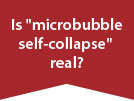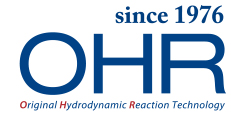About Us
What is OHR technology?
OHR (Original Hydrodynamic Reaction) technology handles both fluids (gases and liquids) and slurries (powder suspended in liquid). Fluids are passed through a special pipe (OHR MIXER or OHR AERATOR), where they are instantaneously broken down into ultrafine particles. Fluid mixing and reaction are thus significantly accelerated.
The MIXER and AERATOR consist of two kinds of uniquely-shaped separating elements, which can only be found in OHR products and offer unparalleled performance.
In one particular case involving emulsification, a resin manufacturer had been using conventional high-pressure (50 MPa) emulsification equipment costing in excess of $200,000 in its production line. After testing the performance of the OHR MIXER, this conventional equipment was replaced with a $3,800 OHR MIXER running at a pressure of 0.5 MPa — just 1% of that required by the old equipment. The OHR MIXER’s powerful mixing capabilities enable it to perform the same function as the high-pressure emulsification equipment at just 1% of the pressure.
Our other flagship product, the OHR AERATOR, is an innovative air diffuser that possesses a powerful gas–liquid mixing function. It can be used not only for wastewater treatment but also for accelerating chemical reactions. It has been independently verified to operate clog-free even in harsh environments that rapidly clog up other air diffusers.
Let OHR technology be your solution and your gateway to innovative new products.
Technological philosophy
OHR technology was created and developed entirely by one Japanese man, Masahiro Takeda (1921–1995); here is his philosophy on technology. This is described in more detail in Noguchi Institute Annual Report No. 30 published by the Noguchi Institute on October 1st, 1987.
- Fluid must be regarded as a cluster or continuum of fluid particles and not merely seen as a “mass” of fluid.
- Conventional technology is limited in that even when one of the two fluids is broken down into fine particles, these end up being carried away by the other fluid flow, resulting in extremely brief contact and reaction.
- In order to accelerate reactions as much as possible, the resistance of the fluid particle film must be minimized, thereby ensuring that the time behind the reaction is also minimized. To this end, it is necessary to minimize the size of the individual fluid particles and instantaneously induce both physical changes via low-temperature boiling as well as continuous collisions between pairs of particles.
This philosophy of Takeda’s is a jewel in the history of fluid treatment technology. But his true genius was in converting this abstract philosophy into concrete mathematical formulae and optimal structures in order to realize the fundamental mechanisms of OHR fluid reaction technology outlined below.
- The instant the cluster/continuum of fluid particles passes through the specialized structure, its chains are broken apart, creating countless individual particles.
- By using the physical properties of the individual fluid particles, they can be made to zigzag back and forth between high and low pressure regions inside the pipe, which results in low-temperature boiling. At the same time, the centrifugal and centripetal forces cause a succession of violent collisions between the particles.
With its simple and intelligent design, the unique internal structure of the OHR pipe has been proven effective over many years and is on the cutting edge of fluid technology to this very day. It is easy to see from its outstanding track record that OHR fluid reaction technology is far superior to conventional such technology.
Real-world examples
Mechanism diagram
Our contribution to the future
1. In the field of environmental technology
Wastewater treatment chemicals (e.g. chlorine, antimicrobials, deodorizers) are useful but also harmful to the environment. Heavy-handed methods that rely on chemicals go against ecology, and therefore cannot be said to be ‘smart’ environmental technology. We will continue to work towards solving environmental issues using OHR technology created by Takeda, who expressed a sincere wish to solve such global problems. We provide technology for many situations in order to reduce chemical costs and solve these environmental problems, as outlined in the following examples.
OHR ozone treatment that is both inexpensive and highly efficient
Improvement of existing conventional DAF systems (flotation separation equipment) to drastically reduce flocculants
Drastically reduces the amount of disinfectant required in white water (produced as part of papermaking)
2. In the field of production technology
Today’s production technology requires bulky, complex production equipment, a large number of professional engineers, and enormous amounts of capital — to say nothing of the large losses associated with mass production.
OHR technology, on the other hand, is an integral part of compact and smart production equipment, which enables production facilities to be smaller and built in larger numbers all around the country, rather than being concentrated in one location. This minimizes losses associated with production. By enabling production facilities to be built in this way, a stronger, more vibrant, and more geographically-diverse society can be realized.
Company profile
| Company Name | OHR LABORATORY CORPORATION |
|---|---|
| Established | April 8th, 1993 (OHL LABORATORY CORPORATION was established in 1976 and is the predecessor of OHR LABORATORY CORPORATION) |
| Business description |
|
| Capital stock | 10,000,000 JPY |
| Address | 536-1, Noda, Irumashi, Saitama 358-0054 JAPAN |
| Phone / Fax | ☎️ +81(0) 4-2932-5466 📠 +81(0) 4-2932-5605 |
| Demonstration room | 6-1, Minamishincho, Hachioji, Tokyo 192-0075 JAPAN |
Company history
| 1972 | Masahiro Takeda opens the Takeda Fluid Engineering Laboratory in Setagaya-ku, Tokyo and begins research into fluid reaction accelerator technology. |
|---|---|
| 1976 |
|
| 1980 | NASA invites Takeda to give a lecture on OHL fluid reaction acceleration technology at the University of Southern California, presided over by Professor Dan. |
| 1983-1993 | Takeda sets up the laboratory at the Noguchi Institute (Itabashi-ku, Tokyo) and conducts various experiments and research. |
| Apr. 1993 | OHL Laboratory Corporation is founded as the successor of OHL Corporation. Mr. Hideto Uematsu (the current president) becomes president of the company. |
| Apr. 1997 | OHL Laboratory Corporation begins a marketing alliance with Seika Corporation. |
| May. 1997 | OHL Laboratory Corporation is reorganized and renamed OHR Corporation (doing business as OHR Laboratory Corporation). |
| Jun. 2000 | OHR equipment sales in Japan exceeds 1,000 factories. |
| Oct. 2002 | OHR equipment sales in Japan exceeds 1,500 factories. |
| Mar. 2006 | OHR equipment sales in Japan exceeds 2,700 factories. |
| May. 2006 | The Decompo system for reducing the volume of excess biological sludge debuts at the New Environmental Exposition 2006. |
| Jun. 2007 | OHR equipment sales in Japan exceeds 3,100 factories. |
| Aug. 2007 | Marketing alliance with Seika Corporation comes to an end. The OHR AERATOR AE-130N (made of polypropylene), a full revamp of the AE-130, makes its debut. |
| Sep. 2007 | Makafine, a flavoring and perfuming machine for shochu (a type of Japanese alcoholic beverage), makes its debut. This revolutionary machine generates microbubbles to separate the fat and oil in shochu ingredients and carry it to the surface. |
| Aug. 2012 | OHR equipment sales in Japan exceeds 3,400 factories. |
| Sep. 2016 | OHR equipment sales in Japan exceeds 4,000 factories. |
| Oct. 2016 | The OHR AERATOR AE-50N (made of polypropylene), a full revamp of the AE-50, makes its debut. |
| Jun. 2019 | Heat resistance and strength of the AE-130N enhanced by changing material to 30% talc-filled polypropylene. |
Patents
OHR technology is patented in the following twelve countries: the USA, Canada, the UK, Germany, France, Denmark, Switzerland, Italy, the Netherlands, the former Soviet Union, Japan, South Korea, Taiwan, Australia and Brazil.
A total of 42 patents have now been granted worldwide.












